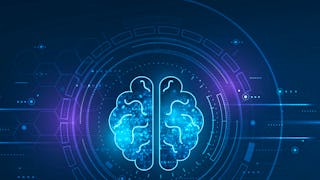Use statistical learning techniques like linear regression and classification to solve common machine learning problems. Complete short coding assignments in Python.



Machine Learning Essentials
Ce cours fait partie de Spécialisation AI and Machine Learning Essentials with Python


Instructeurs : Chris Callison-Burch
Inclus avec 
Expérience recommandée
Expérience recommandée
Ce que vous apprendrez
Review probability basics and understand essential theoretical framework to analyze statistical learning problems.
Use linear regression and Python programming to solve machine learning problems.
Détails à connaître

Ajouter à votre profil LinkedIn
12 devoirs
Découvrez comment les employés des entreprises prestigieuses maîtrisent des compétences recherchées

Élaborez votre expertise du sujet
- Apprenez de nouveaux concepts auprès d'experts du secteur
- Acquérez une compréhension de base d'un sujet ou d'un outil
- Développez des compétences professionnelles avec des projets pratiques
- Obtenez un certificat professionnel partageable


Obtenez un certificat professionnel
Ajoutez cette qualification à votre profil LinkedIn ou à votre CV
Partagez-le sur les réseaux sociaux et dans votre évaluation de performance

Il y a 4 modules dans ce cours
This module introduces the standard theoretical framework used to analyze statistical learning problems. We start by covering the concept of regression function and the need for parametric models to estimate it due to the curse of dimensionality. We continue by presenting tools to assess the quality of a parametric model and discuss the bias-variance tradeoff as a theoretical framework to understand overfitting and optimal model flexibility.
Inclus
8 vidéos1 lecture3 devoirs1 devoir de programmation
In this module, we cover the problem of linear regression. We start with a formal statement of the problem, we derive a solution as an optimization problem, and provide a closed-form expression using the matrix pseudoinverse. We then move on to analyze the statistical properties of the linear regression coefficients, such as their covariance and variances. We use this statistical analysis to determine coefficient accuracy and analyze confidence intervals. We then move on to the topic of hypothesis testing, which we use to determine dependencies between input variables and outputs. We finalize with a collection of metrics to measure model accuracy, and continue with the introduction to the Python programming language. Please note, there is no formal assignment this week, and we hope that everyone participates in the discussion instead.
Inclus
7 vidéos3 devoirs1 sujet de discussion
In this module, you will learn how to include categorical (discrete) inputs in your linear regression problem, as well as nonlinear effects, such as polynomial and interaction terms. As a companion to this theoretical content, there are two recitation videos that demonstrate how to solve linear regression problems in Python. You will need to use this knowledge to complete a programming project.
Inclus
7 vidéos3 devoirs1 devoir de programmation
In this module, we introduce classification problems from the lens of statistical learning. We start by introducing a generative model based on the concept of conditional class probability. Using these probabilities, we show how to build the Bayes optimal classifier which minimizes the expected misclassification error. We then move on to present logistic regression, in conjunction with maximum likelihood estimation, for parametric estimation of the conditional class probabilities from data. We also extend the idea of hypothesis testing to the context of logistic regression.
Inclus
7 vidéos1 lecture3 devoirs1 devoir de programmation
Instructeurs

Offert par
En savoir plus sur Machine Learning


University of Pennsylvania


Politecnico di Milano


Sungkyunkwan University


University of Pennsylvania
Pour quelles raisons les étudiants sur Coursera nous choisissent-ils pour leur carrière ?





Ouvrez de nouvelles portes avec Coursera Plus
Accès illimité à 10,000+ cours de niveau international, projets pratiques et programmes de certification prêts à l'emploi - tous inclus dans votre abonnement.
Faites progresser votre carrière avec un diplôme en ligne
Obtenez un diplôme auprès d’universités de renommée mondiale - 100 % en ligne
Rejoignez plus de 3 400 entreprises mondiales qui ont choisi Coursera pour les affaires
Améliorez les compétences de vos employés pour exceller dans l’économie numérique
Foire Aux Questions
Access to lectures and assignments depends on your type of enrollment. If you take a course in audit mode, you will be able to see most course materials for free. To access graded assignments and to earn a Certificate, you will need to purchase the Certificate experience, during or after your audit. If you don't see the audit option:
The course may not offer an audit option. You can try a Free Trial instead, or apply for Financial Aid.
The course may offer 'Full Course, No Certificate' instead. This option lets you see all course materials, submit required assessments, and get a final grade. This also means that you will not be able to purchase a Certificate experience.
When you enroll in the course, you get access to all of the courses in the Specialization, and you earn a certificate when you complete the work. Your electronic Certificate will be added to your Accomplishments page - from there, you can print your Certificate or add it to your LinkedIn profile. If you only want to read and view the course content, you can audit the course for free.
If you subscribed, you get a 7-day free trial during which you can cancel at no penalty. After that, we don’t give refunds, but you can cancel your subscription at any time. See our full refund policy.
Plus de questions
Aide financière disponible,

